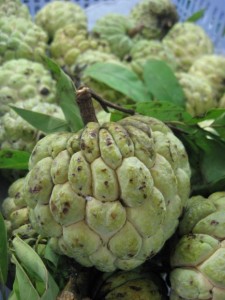The custard-apple, also called bullock’s heart or bull’s heart, is the fruit of the tree Annona reticulata. This tree is a small deciduous or semi-evergreen tree sometimes reaching 10 metres (33 ft) tall and a native of the tropical New World that prefers low elevations, and a warm, humid climate. It also occurs as feral populations in many parts of the world including Southeast Asia, Taiwan, India, Australia, and Africa.
The fruits are variable in shape, heart shaped, oblong or irregular. The size ranges from 7 centimetres (2.8 in) to 12 centimetres (4.7 in). When ripe, the fruit is brown or yellowish, with red highlights and a varying degree of reticulation, depending on variety. The flavor is sweet and pleasant.
In some regions of the world, “custard-apple” is another name for sugar-apple or sweetsop (Annona squamosa), a different plant in the same genus. In Britain, “custard-apple” refers to cherimoya, the fruit of Annona cherimola, a third plant in the same genus.
Uses
Food
The fruit is good to eat as is but also makes a sweet drink and can be used as a milk substitute.
Medicinal
The unripe fruit has been used to assist against diarrhea and dysentery. The tree bark is used for skin and mucosae medicines and the seed bark contains useful tannins and astringents. The leaves are believed to have healing properties and have been used against tumors and cancers. The bark has been used on gums to relieve toothaches.
Other
The leaves also provide ingredients used to make dyes, stains, inks, tattoos and mordants. The whole plant is a source of hydrogen cyanide.
Fatty-acid methyl ester of the seed oil meets all of the major biodiesel requirements in the USA (ASTM D 6751-02, ASTM PS 121-99), Germany (DIN V 51606) and European Union (EN 14214).
Cultivars
Tikal
is of excellent quality and medium yield; its flesh is bright-red, except in the white areas surrounding the seeds.
Canul
has a medium fruit with a waxy, shiny dark-red surface and purplish red flesh; it is very aromatic and deliciously sweet with few concretions of hard cells.
Sartenaya
has a medium fruit with a waxy, shiny red surface and pink flesh with a magnificent taste and texture. Although the fruit is not as attractive in appearance as that of the previous two cultivars. the tree is sturdier.
San Pablo
has a long, large fruit with an opaque, light-red surface. The flesh is dark-pink with a good aroma and taste. It is a vigorous, productive cultivar.
Benque
has a big conical fruit with a dark-red surface and very tasty dark-pink flesh.
Caledonia
has a small fruit with a dark surface: it is very attractive to cochineal insects (Philophaedra sp.), which are not very common in other varieties. The flesh is pink and has an excellent taste.
Chonox
has a medium fruit with a red skin and juicy. very tasty pink flesh; it is very productive and, for this reason, often has low-quality fruit. It produces abundant flowers in groups of up to 16.
Recipes:
Lets see, I will update them soon.


